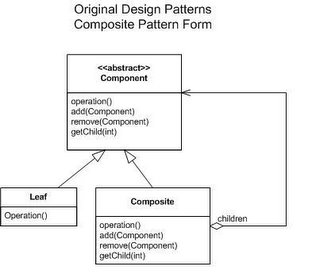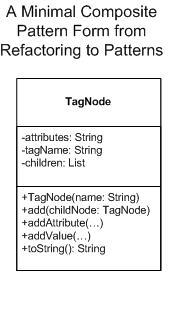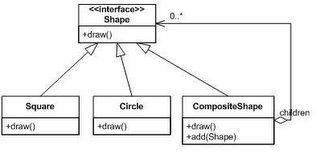Pattern drift
When I first reviewed Design Patterns, I recommended it be published as a loose-leaf notebook. I suggested that authors provide regular updates (this was before the Internet was readily available!). I anticipated frequent updates and many more additions. 23 patterns didn’t seem like nearly enough.
Fast forward to 2006. Design Patterns has been in print unchanged for 12 years. Although recognized as a landmark book, it needs refreshing. In fairness, the book was so popular that there was little motivation to do so. An update is supposedly in the works.
I give my students the original text, but they struggle to read it and find relevance (C++ and graphics examples are a stretch for most). I always point them to other sources, both online and in print, to fill in the gaps. Many have written their own take on specific patterns. That is a good thing. In 1998, in a C++ Report article, John Vlissides acknowledged that pattern definitions aren’t cast in stone.
It seems you can’t overemphasize that a pattern’s structure diagram (class diagram) is just an example, not a specification. It portrays the implementation we see most often. As such, the Structure diagram will probably have a lot in common with your own implementation, but differences are inevitable and actually desirable. At the very least you will rename the participants as appropriate for your domain. Vary the implementation trade-offs, and your implementation might start looking a lot different from the Structure diagram.
In Refactoring to Patterns, Josh Kerievsky quotes Vlissides and then after illustrating the original Composite pattern:
Gives his own take on a single-class implementation:
Hmm. A single concrete class that could support either leaf or composite behaviors. Now that’s a thought—but is it still recognizable as a composite pattern? Sure, but what is it that makes a composite a composite and not just another structuring mechanism? Is it just a fancy name for a "tree structuring mechanism" or is there something more?
Bob Martin, in Agile Software Development, presents another variation. He illustrates composite with a Shape interface which defines a single method-draw(). That interface is realized by classes that are either primitive shapes or composed of other shape objects.
In 1994 when Design Patterns was published, interfaces weren’t present in popular programming language. The authors relied on abstract class definitions instead. Since I spend my time with C# and Java, today I’d likely recast many GOF patterns using interfaces instead of abstract classes, especially when there isn’t any common meaningful behavior to inherit.
But Bob’s example illustrates another important design choice. He didn’t force-fit composite behavior into a common abstraction shared by both composite and leaf objects. He isn’t alone in making this tradeoff. Many of my students after struggling to define meaningful operations common to both, throw up their hands and grumble that the GOF authors made the wrong tradeoffs when they specified the composite pattern. This sentiment is echoed on a RICE webpage:
In Design Patterns, the abstract component AComponent is shown as having accessor methods for child AComponents. They are not shown here because it is debatable as to whether one wants the Client to fundamentally view the Component as a single component or as a collection of components. Design Patterns models all Components as collections while the above design models them all as single components. The exact nature of those accessor methods is also debatable.
Debating design tradeoffs is healthy. That’s why I give my students GOF undistilled and we discuss tradeoffs as they learn patterns. This helps them gain design confidence as they articulate their values and say what they like and don’t like about the patterns as presented. But sometimes I think they’d prefer a simple canonical pattern form they could just use without much thought. I often point them to the Data & Object Factory website which has a quick pocket guide discussion of each pattern. But the composite pattern sample implementation there defines an abstract Shape class with empty add() and remove() methods. And leaf classes implemented add or remove by writing a console message, "can’t add/draw a shape to an xxx" A toy solution if I ever saw one! Perhaps if I paid $79 to purchase their Design Patterns Framework I’d see a more realistic implementation.
This leads me to wonder: what makes a pattern useful, how much change can or should it undergo, and how much stewardship should there be over pattern drift, pattern evolution and pattern explanations? I don’t expect patterns to be fixed and unchangeable. They should wiggle around a bit. But I like thoughtful discussions and reasonable examples. I wish there was a community that maintained an active PatternPedia repository where authors would be encouraged to keep their patterns up to date and where there were useful teaching examples, thoughtful reviews, and summaries of both new and classic patterns. The Portland Pattern Repository is a springboard for patterns, but it doesn’t seem very active. The Hillside website is useful, but it just points to other sources. I have more in mind a cross between Wikipedia and Amazon with an edge and an active editor/convener whose job is to keep us informed of the latest breaking pattern news. Sure I can search the internet and books for patterns. But my search feels scattered. I never know when I’ll stumble across some arcane shift, a mangling of a pattern’s intent, or a good trend to follow. It’s too hit and miss.
Currently, most patterns are copyrighted by authors and are locked up in relatively static media books or conference proceedings or magazine articles or static online versions of the same. There’s no central source, no common repository for a growing body of pattern wisdom gained from experience. So when pattern interpretations shift, as they invariably do, it is in a quirky ad hoc manner. I don’t mind Kerievsky’s compact interpretation of Composite. I just wish his version was accessible to those who didn’t buy his book, and that there was a place for open debate about the merits of this implementation choice that was readily linked to other Composite pattern interpretations. Is this asking too much? Isolated works make it difficult to change/refine/ invigorate patterns with in a larger community of users/developers/pattern authors. What would it take to create a patterns commons? I’d be interested in hearing your thoughts.
- Previous: Alan Shalloway’s Hat Trick
- Next: False Dichotomies and Forced Divisions


